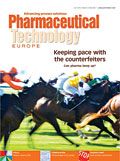Can Pharma Keep Pace With The Counterfeiters?
This month, PTE speaks with experts to reveal the true extent of the threat that counterfeiting presents to the pharmaceutical industry.
The full version of this counterfeiting feature can be read in the July issue of our digital magazine: http://www.pharmtech.com/ptedigital0710
The problem of counterfeit medicines was first addressed at an international level in 1985, when a conference of experts recommended that the World Health Organization (WHO), together with other international and non-governmental organisations, should study the feasibility of setting up a clearing house to collect data and to inform governments about the nature and extent of counterfeiting. Since then, however, the problem has only escalated. According to the WHO, the magnitude of the issue is difficult to assess because of the variety of information sources available.1 Additionally, the WHO stresses that counterfeiters are extremely flexible and can change their methods from day to day, so the results of a study may already be out of date the day they are released.
However, the statistics that are available show unsettling results. For example, compared with 2005, seizures of counterfeit medicines at the EU border increased by 380% in 2007.2 Meanwhile, research commissioned by Aegate revealed that 5% of consumers across five European countries suspect they may have received a counterfeit prescription drug.3 The research adds that the majority of consumers believe that the trade in counterfeit medicines is largely the responsibility of the manufacturer.

Jason Hosking/Getty Images
Fortunately, the threat of counterfeits has prompted the development of a number of anti-counterfeiting solutions, from simple holograms and watermarks, to sophisticated barcodes that enable track and trace, tagged packages, and even technologies that can be applied directly to individual tablets. But which solution is most widely used by the pharma industry?
To get a better idea, PTE conducted a survey4 of industry executives and found that, although barcoding and tamper-evident packaging was the most popular solution in use amongst those surveyed, astonishingly, the majority of respondents (27%) admitted that their company had yet to instate an anti-counterfeiting solution (Figure 1).

Figure 1
Products can never be made completely secure against counterfeiting; however, counterfeiters will always target medicines that are easiest to copy. In the EU, companies that have yet to implement a solution are going to have to move quickly in light of the significant threat that counterfeiting presents as well as amendments that are being made to the current EU anti-counterfeiting directive; one of which mandates safety features, such as seals or serial numbers, for certain medicines.5
Speaking to a variety of industry leaders, PTE examines some of the trends in anti-counterfeiting technologies, as well as the innovative solutions being used by the industry.
References
1. WHO, Medicines: counterfeit medicines, Fact sheet N°275 (2010). www.who.int
2. European Commission, Counterfeit Medicines (2010). http://ec.europa.eu
3. Aegate, Medicines top counterfeit concern list in Europe — consumers call for tougher safety measures (2009). www.aegate.com
4. www.pharmtech.com/counterfeitpoll
5. European Parliament, Fake medicines: MEPs want to target online sales (2010). www.europarl.europa.eu

Transformations in Drug Development for Cell and Gene Therapies
March 28th 2025As a recognized leader in immunophenotyping for clinical trials, Kevin Lang from PPD discusses how spectral flow cytometry is transforming drug development, particularly in cell and gene therapies like CAR-T. He also dives into his award-winning research, including his 2024 WRIB Poster Award-winning work, and his insights from presenting at AAPS PharmSci360.
Advancing Clinical Trials with Spectral Flow Cytometry: A Conversation with Kevin Lang
March 28th 2025As a recognized leader in immunophenotyping for clinical trials, Kevin Lang from PPD discusses how spectral flow cytometry is transforming drug development, particularly in cell and gene therapies like CAR-T. He also dives into his award-winning research, including his 2024 WRIB Poster Award-winning work, and his insights from presenting at AAPS PharmSci360.
Pharmaceutical Tariffs Are Imminent: How Industry is Bracing for Impact
April 16th 2025On April 14, 2025, the Trump Administration launched a national security-driven investigation into pharmaceuticals, a move that will likely result in tariffs being placed on pharmaceutical drugs, ingredients, and other components that are imported from outside of the United States.